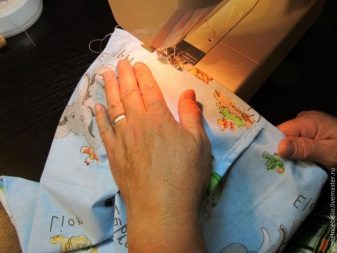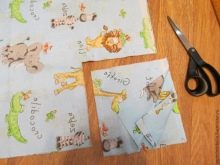How to sew baby bedding?

The birth of a child is an exciting and thrilling event for all family members. A newborn baby needs love, increased attention and care. The purchase of baby clothes, cots, strollers, bed linen and toys begins long before the birth of a baby, for whom parents choose only high-quality products from well-known manufacturers. On the shelves of specialized children's stores, you can see a huge assortment of goods in this group.
The high price of basic necessities surprises not only young parents, but also families who already have children. You can reduce material costs by making your own children's clothes and bedding.
If mothers who know how to sew and knit can make things for a child, then even parents with minimal knowledge of needlework will be able to sew bed linen for crumbs.



Which material should you choose?
Self-production of children's bedding will make it possible not only to choose the material you need, the colors and style of the set, but also to make bright decorative applications.
The correct choice of fabric is the key to a comfortable sleep for your child. Experts do not recommend choosing artificial materials. Cotton-based bedding is the best option for newborns. Among the main advantages of natural material, the following should be highlighted:
- practicality;
- lack of allergic components;
- delicate texture;
- comfortable sleep.
The most popular are sets of satin, poplin, calico, phlox, bamboo.



Calico
Most manufacturers prefer coarse calico. Calico has a smooth surface and a loose structure, which contributes to the unimpeded movement of air and moisture. These indicators are important for newborn babies.
Advantages:
- high level of density;
- friction resistance;
- ease of care;
- absence of electric charges on the surface;
- long-term preservation of shape and color;
- no shrinkage;
- affordable price range;
- the ability to use at any time of the year.
Disadvantages: pile rolling, dull colors.



Poplin
Poplin is a modern analogue of coarse calico, sales of which are increasing annually. This material has the following positive parameters:
- flexibility;
- opacity;
- ease;
- airiness.
Among the disadvantages of the material, it can be noted that it rolls down strongly.



Chintz
It is undesirable to put delicate and soft cotton linen in a crib, due to its low resistance to mechanical damage and rapid fading of the pattern.
Advantages: affordable price, large color range, no wrinkles after washing.
Disadvantages: poor curling of threads, thinness, wash only in a delicate mode at a low temperature.



Satin
Satin is a dense material with a smooth surface. It is good in maintenance, but has a serious drawback - a high price range.



Bamboo
Bamboo products not only have high levels of hygroscopicity and moisture permeability, but also have high strength, absorb odor, have antimicrobial and anti-mite properties.
Nevertheless, the price for such material will not be small at all.



Flannel
For the manufacture of a winter bedding set, experts recommend paying attention to flannel. Among the main advantages of the fabric are the following:
- the use of only natural dyes;
- long period of operation;
- resistance to mechanical friction;
- preservation of delicate texture after repeated washing;
- heat preservation;
- the presence of fleece.
Disadvantages:
- long drying period;
- high percentage of shrinkage.



Less common types of fabric are satin, satin luxury, polyester, ranfors, super cotton.
Before buying the necessary material, it is imperative to look at the quality certificates, in which the manufacturer indicates the safety level of the paint used, the density of the threads and their quality. Information about the duration and mode of washing is also necessary. The percentage of shrinkage of the material after washing is reflected in the quantity of the purchased item.
Professional seamstresses recommend choosing material for multiple sets, the color scheme of which would have common tones, and the products would be harmoniously combined with each other. Such a trick will help young parents not to completely change their underwear, but to remove only the soiled items, and replace them with parts of another set.
The color scheme of baby bedding is a very important indicator that will affect a child's sleep. You cannot choose material with large and bright patterns that will not only scare the newborn, but will also look dull and untidy after a lot of washes.
Shades of linen should be calm, warm, and non-aggressive. Professional psychologists recommend giving preference to blue, pink and beige colors.


How to calculate the amount of material?
In order that the sewn kit does not have to be redone, it is necessary to take measurements correctly or use standard sizes and make all the necessary calculations.
Standard sizes of baby bedding set:
- pillowcase: height - 40 cm, length - 60 cm;
- sheet: width - 110 cm, length - 140 cm;
- duvet cover: length - 140 cm, width - 100 cm.
Before buying fabric, it is imperative to measure the pillow and mattress, the dimensions of which may differ significantly from the standard ones.


To make one standard set, you need to buy at least four meters of material, and for non-standard mattresses and pillows, the fabric consumption is much higher. It is necessary to add at least 15 cm to this length for shrinkage on each product, and for each edge add another 1.5 cm for the seam.
Before proceeding with the process of cutting out all parts of the bedding, it is necessary to complete the preparatory work, which consists of washing, drying and ironing all the material. These works will lead to shrinkage of the whole material, and exclude deformation of finished products.
For the rational use of fabric, it is necessary to correctly arrange all the elements of the product on the canvas. Experienced seamstresses and specialized literature will tell you the rules for the simultaneous arrangement of all parts of the bedding set.
These guidelines will help reduce waste and unnecessary material residues.

With the help of a ruler and chalk, it is necessary to draw all the necessary lines, the size of which should correspond to the measurements taken. Instead of chalk, you can use small and thin remains of toilet soap.
The transverse placement of kit parts will reduce the amount of scrap. For a harmonious arrangement of patterns, you need to choose a fabric with a scattered pattern or an image near the edge.

How to sew correctly?
Making bedding with your own hands may seem like a laborious process, but this type of work has a number of indisputable advantages:
- making a set of the required size;
- independent choice of design and colors;
- rational use of the family budget.
Before you start sewing bed linen yourself, you need to take care of purchasing the necessary tools and accessories:
- centimeters;
- rulers;
- sewing needles;
- cutting scissors;
- dry chalk or remnant;
- threads of the required color;
- sewing machines;
- ironing board and iron.
After cutting out all the parts, you can start sewing the kit. Professional seamstresses perform these works in any sequence, and for novice craftswomen it is better to start sewing from a sheet.


A master class from specialists in needlework, and step-by-step instructions for performing work will greatly simplify the work of novice housewives.
Pillowcase
Making a pillowcase is not a complicated step in the production of bedding. To complete it, you need to fold the product so that the front side is inside. Sew all the edges, and on one side, leave an unexpired place with a length of about 20 cm to form the flap. Unscrew the finished product, and fill the valve inward. Carefully straighten and straighten the corners of the finished pillowcase.
Before putting a pillow in a new pillowcase on a baby's crib, you should carefully study the recommendations of medical professionals, who categorically prohibit using this item in a baby's crib. Only a child over the age of two can sleep on a pillow.

Duvet cover
The pattern of the duvet cover must necessarily correspond to the size of the duvet. The blank of the product must be folded inside out to inside out, and all sides must be stitched, and the cut must be overcast. On one side, you should leave about 40 cm unused for the blanket. Turn out the finished product and carefully straighten all corners.


Sheet
This product is the easiest to manufacture. Before starting work, you need to decide what it will be. There are three types of sheets:
- simple;
- on an elastic band;
- on an elastic band.
To make a simple rectangular product, it is enough to simply hem all sides, tucking them twice by 0.5 cm each, or sweep over the cut, and only then hem the edges, tucking them up once. Beginner seamstresses should first baste the folded edges and then machine the seam. The threads should be chosen in a contrasting color and neat stitches should be made so that they do not leave marks after removal.
If the sheet was cut on the standard pattern, then the two sides already have a finished border and do not need to be hemmed again. In the case of rough fabrication, these sides must be re-hemmed as well.
Making a product with an elastic band is a more time-consuming and laborious process that requires a certain amount of experience.
Mothers with several children recommend this particular type of sheet, which will prevent the product from wrinkling in the crib, and will reduce the number of restorations.



The amount of fabric for a sheet with an elastic band should be taken more than for a regular one. When determining the size of the product, it is necessary to take into account the fit of the mattress, allowances for the seams and the drawstring for the elastic. The standard size of the product is 150 x 110 cm. The corners of the sheet must be sewn so that the product fits snugly around the mattress. Sew the edges, taking into account the placement of the elastic, and distribute it evenly over the entire prepared edge.
A simpler and more convenient option for a sheet with an elastic band is a product with an elastic band.
Making baby bedding yourself is a creative process. Parents want not only to make quality bedding, but also to decorate it. Before choosing decorative elements, it is imperative to take into account the age of the child.
It is strictly forbidden to use zippers, rhinestones, buttons, Velcro and other items that can harm a newborn for decoration. To decorate bed linen, you can use frills, ruffles, decorative ribbons and multi-colored borders.



The sewn and decorated product must be washed with baby soap or powder, dried and ironed with a hot iron. An additional check of all parts of the kit for needles and pins is a prerequisite.Iron magnets can be used to locate lost needles.
In the case of purchasing a finished product, you must ask the seller for a quality certificate for this group of products, which should include GOST 31307-2005. The purchase of poor quality bedding can negatively affect the health of the newborn baby.
See the next video for a master class on sewing a sheet with an elastic band.













The comment was sent successfully.